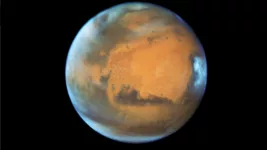Mars will make its closest approach to Earth in a decade, this month, providing sky-watchers with a celestial show from dusk to dawn starting this week, NASA said on Thursday.
The red planet already looms large in the night sky, appearing as a bright, fire-yellow, star.
Alan MacRobert, Editor, Sky and Telescope Magazine
Just look southeast after the end of twilight, and you can’t miss it.
This alignment occurs about every 26 months.
On Thursday, NASA released a photograph of Mars taken by the Hubble Space Telescope as the planet neared Earth last week. The detailed image showed polar caps and clouds above Mars’ rust-hued landscape.
On 30 May, Mars and Earth will come closer than they have been in a decade, NASA said. Mars will be 46.8 million miles (75.3 million km) away.
The distance between Earth and Mars reaches up to about 250 million miles (400 million km) depending on the ever-changing positions of the two planets as they circle around the sun.
If skies are clear, Mars will be visible for much of the night and can be easily seen without a telescope or binoculars.
Mars has been even closer to Earth before. In August 2003, Earth and Mars were just 35 million miles (56 million km) apart, a quirk stemming from the planets’ slightly oval-shaped orbits around the sun.
It will be almost 300 years before the planets come that close again.
(Published in an arrangement with Reuters)








